Sebastian Nowozin
Microsoft Research Cambridge
AlphaEvolve: A coding agent for scientific and algorithmic discovery
Jun 16, 2025Abstract:In this white paper, we present AlphaEvolve, an evolutionary coding agent that substantially enhances capabilities of state-of-the-art LLMs on highly challenging tasks such as tackling open scientific problems or optimizing critical pieces of computational infrastructure. AlphaEvolve orchestrates an autonomous pipeline of LLMs, whose task is to improve an algorithm by making direct changes to the code. Using an evolutionary approach, continuously receiving feedback from one or more evaluators, AlphaEvolve iteratively improves the algorithm, potentially leading to new scientific and practical discoveries. We demonstrate the broad applicability of this approach by applying it to a number of important computational problems. When applied to optimizing critical components of large-scale computational stacks at Google, AlphaEvolve developed a more efficient scheduling algorithm for data centers, found a functionally equivalent simplification in the circuit design of hardware accelerators, and accelerated the training of the LLM underpinning AlphaEvolve itself. Furthermore, AlphaEvolve discovered novel, provably correct algorithms that surpass state-of-the-art solutions on a spectrum of problems in mathematics and computer science, significantly expanding the scope of prior automated discovery methods (Romera-Paredes et al., 2023). Notably, AlphaEvolve developed a search algorithm that found a procedure to multiply two $4 \times 4$ complex-valued matrices using $48$ scalar multiplications; offering the first improvement, after 56 years, over Strassen's algorithm in this setting. We believe AlphaEvolve and coding agents like it can have a significant impact in improving solutions of problems across many areas of science and computation.
Timewarp: Transferable Acceleration of Molecular Dynamics by Learning Time-Coarsened Dynamics
Feb 02, 2023



Abstract:Molecular dynamics (MD) simulation is a widely used technique to simulate molecular systems, most commonly at the all-atom resolution where the equations of motion are integrated with timesteps on the order of femtoseconds ($1\textrm{fs}=10^{-15}\textrm{s}$). MD is often used to compute equilibrium properties, which requires sampling from an equilibrium distribution such as the Boltzmann distribution. However, many important processes, such as binding and folding, occur over timescales of milliseconds or beyond, and cannot be efficiently sampled with conventional MD. Furthermore, new MD simulations need to be performed from scratch for each molecular system studied. We present Timewarp, an enhanced sampling method which uses a normalising flow as a proposal distribution in a Markov chain Monte Carlo method targeting the Boltzmann distribution. The flow is trained offline on MD trajectories and learns to make large steps in time, simulating the molecular dynamics of $10^{5} - 10^{6}\:\textrm{fs}$. Crucially, Timewarp is transferable between molecular systems: once trained, we show that it generalises to unseen small peptides (2-4 amino acids), exploring their metastable states and providing wall-clock acceleration when sampling compared to standard MD. Our method constitutes an important step towards developing general, transferable algorithms for accelerating MD.
High-bandwidth Close-Range Information Transport through Light Pipes
Jan 19, 2023



Abstract:Image retrieval after propagation through multi-mode fibers is gaining attention due to their capacity to confine light and efficiently transport it over distances in a compact system. Here, we propose a generally applicable information-theoretic framework to transmit maximal-entropy (data) images and maximize the information transmission over sub-meter distances, a crucial capability that allows optical storage applications to scale and address different parts of storage media. To this end, we use millimeter-sized square optical waveguides to image a megapixel 8-bit spatial-light modulator. Data is thus represented as a 2D array of 8-bit values (symbols). Transmitting 100000s of symbols requires innovation beyond transmission matrix approaches. Deep neural networks have been recently utilized to retrieve images, but have been limited to small (thousands of symbols) and natural looking (low entropy) images. We maximize information transmission by combining a bandwidth-optimized homodyne detector with a differentiable hybrid neural-network consisting of a digital twin of the experiment setup and a U-Net. For the digital twin, we implement and compare a differentiable mode-based twin with a differentiable ray-based twin. Importantly, the latter can adapt to manufacturing-related setup imperfections during training which we show to be crucial. Our pipeline is trained end-to-end to recover digital input images while maximizing the achievable information page size based on a differentiable mutual-information estimator. We demonstrate retrieval of 66 kB at maximum with 1.7 bit per symbol on average with a range of 0.3 - 3.4 bit.
Contextual Squeeze-and-Excitation for Efficient Few-Shot Image Classification
Jun 20, 2022



Abstract:Recent years have seen a growth in user-centric applications that require effective knowledge transfer across tasks in the low-data regime. An example is personalization, where a pretrained system is adapted by learning on small amounts of labeled data belonging to a specific user. This setting requires high accuracy under low computational complexity, therefore the Pareto frontier of accuracy vs.~adaptation cost plays a crucial role. In this paper we push this Pareto frontier in the few-shot image classification setting with two key contributions: (i) a new adaptive block called Contextual Squeeze-and-Excitation (CaSE) that adjusts a pretrained neural network on a new task to significantly improve performance with a single forward pass of the user data (context), and (ii) a hybrid training protocol based on Coordinate-Descent called UpperCaSE that exploits meta-trained CaSE blocks and fine-tuning routines for efficient adaptation. UpperCaSE achieves a new state-of-the-art accuracy relative to meta-learners on the 26 datasets of VTAB+MD and on a challenging real-world personalization benchmark (ORBIT), narrowing the gap with leading fine-tuning methods with the benefit of orders of magnitude lower adaptation cost.
FiT: Parameter Efficient Few-shot Transfer Learning for Personalized and Federated Image Classification
Jun 17, 2022
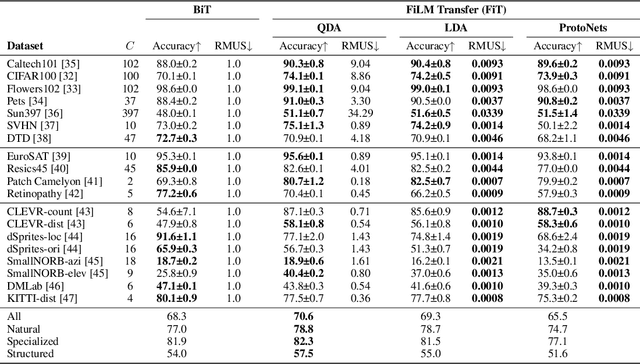

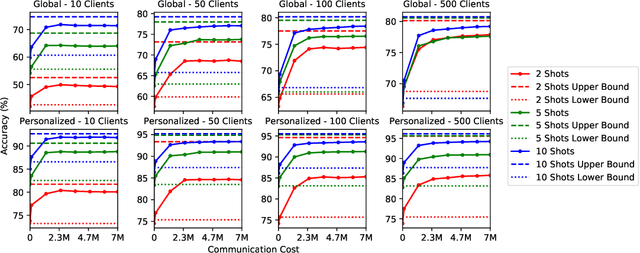
Abstract:Modern deep learning systems are increasingly deployed in situations such as personalization and federated learning where it is necessary to support i) learning on small amounts of data, and ii) communication efficient distributed training protocols. In this work we develop FiLM Transfer (FiT) which fulfills these requirements in the image classification setting. FiT uses an automatically configured Naive Bayes classifier on top of a fixed backbone that has been pretrained on large image datasets. Parameter efficient FiLM layers are used to modulate the backbone, shaping the representation for the downstream task. The network is trained via an episodic fine-tuning protocol. The approach is parameter efficient which is key for enabling few-shot learning, inexpensive model updates for personalization, and communication efficient federated learning. We experiment with FiT on a wide range of downstream datasets and show that it achieves better classification accuracy than the state-of-the-art Big Transfer (BiT) algorithm at low-shot and on the challenging VTAB-1k benchmark, with fewer than 1% of the updateable parameters. Finally, we demonstrate the parameter efficiency of FiT in distributed low-shot applications including model personalization and federated learning where model update size is an important performance metric.
Memory Efficient Meta-Learning with Large Images
Jul 02, 2021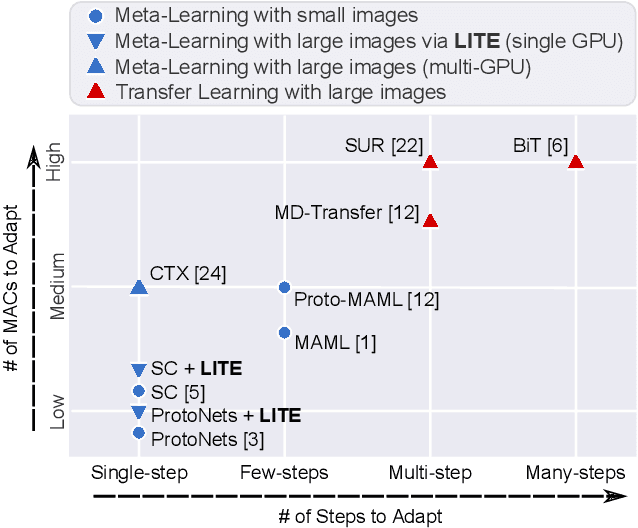
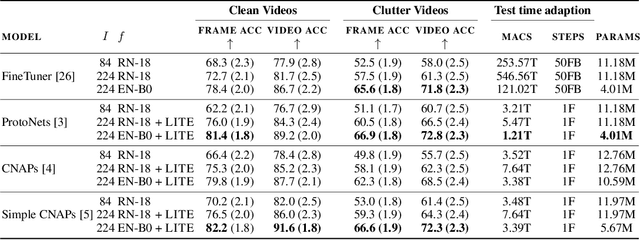

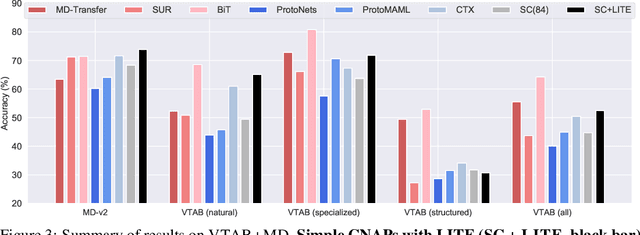
Abstract:Meta learning approaches to few-shot classification are computationally efficient at test time requiring just a few optimization steps or single forward pass to learn a new task, but they remain highly memory-intensive to train. This limitation arises because a task's entire support set, which can contain up to 1000 images, must be processed before an optimization step can be taken. Harnessing the performance gains offered by large images thus requires either parallelizing the meta-learner across multiple GPUs, which may not be available, or trade-offs between task and image size when memory constraints apply. We improve on both options by proposing LITE, a general and memory efficient episodic training scheme that enables meta-training on large tasks composed of large images on a single GPU. We achieve this by observing that the gradients for a task can be decomposed into a sum of gradients over the task's training images. This enables us to perform a forward pass on a task's entire training set but realize significant memory savings by back-propagating only a random subset of these images which we show is an unbiased approximation of the full gradient. We use LITE to train meta-learners and demonstrate new state-of-the-art accuracy on the real-world ORBIT benchmark and 3 of the 4 parts of the challenging VTAB+MD benchmark relative to leading meta-learners. LITE also enables meta-learners to be competitive with transfer learning approaches but at a fraction of the test-time computational cost, thus serving as a counterpoint to the recent narrative that transfer learning is all you need for few-shot classification.
Precise characterization of the prior predictive distribution of deep ReLU networks
Jun 11, 2021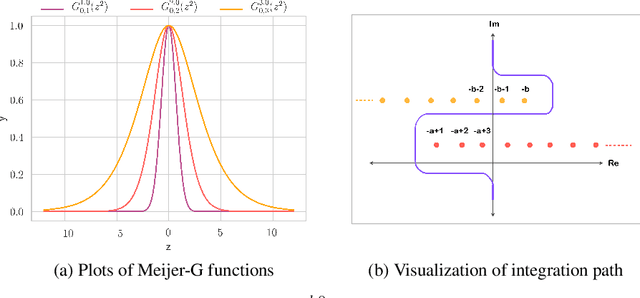


Abstract:Recent works on Bayesian neural networks (BNNs) have highlighted the need to better understand the implications of using Gaussian priors in combination with the compositional structure of the network architecture. Similar in spirit to the kind of analysis that has been developed to devise better initialization schemes for neural networks (cf. He- or Xavier initialization), we derive a precise characterization of the prior predictive distribution of finite-width ReLU networks with Gaussian weights. While theoretical results have been obtained for their heavy-tailedness, the full characterization of the prior predictive distribution (i.e. its density, CDF and moments), remained unknown prior to this work. Our analysis, based on the Meijer-G function, allows us to quantify the influence of architectural choices such as the width or depth of the network on the resulting shape of the prior predictive distribution. We also formally connect our results to previous work in the infinite width setting, demonstrating that the moments of the distribution converge to those of a normal log-normal mixture in the infinite depth limit. Finally, our results provide valuable guidance on prior design: for instance, controlling the predictive variance with depth- and width-informed priors on the weights of the network.
Disentangling the Roles of Curation, Data-Augmentation and the Prior in the Cold Posterior Effect
Jun 11, 2021
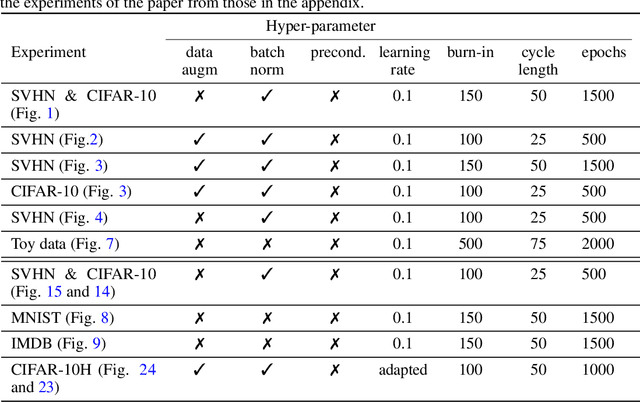


Abstract:The "cold posterior effect" (CPE) in Bayesian deep learning describes the uncomforting observation that the predictive performance of Bayesian neural networks can be significantly improved if the Bayes posterior is artificially sharpened using a temperature parameter T<1. The CPE is problematic in theory and practice and since the effect was identified many researchers have proposed hypotheses to explain the phenomenon. However, despite this intensive research effort the effect remains poorly understood. In this work we provide novel and nuanced evidence relevant to existing explanations for the cold posterior effect, disentangling three hypotheses: 1. The dataset curation hypothesis of Aitchison (2020): we show empirically that the CPE does not arise in a real curated data set but can be produced in a controlled experiment with varying curation strength. 2. The data augmentation hypothesis of Izmailov et al. (2021) and Fortuin et al. (2021): we show empirically that data augmentation is sufficient but not necessary for the CPE to be present. 3. The bad prior hypothesis of Wenzel et al. (2020): we use a simple experiment evaluating the relative importance of the prior and the likelihood, strongly linking the CPE to the prior. Our results demonstrate how the CPE can arise in isolation from synthetic curation, data augmentation, and bad priors. Cold posteriors observed "in the wild" are therefore unlikely to arise from a single simple cause; as a result, we do not expect a simple "fix" for cold posteriors.
TaskNorm: Rethinking Batch Normalization for Meta-Learning
Mar 06, 2020



Abstract:Modern meta-learning approaches for image classification rely on increasingly deep networks to achieve state-of-the-art performance, making batch normalization an essential component of meta-learning pipelines. However, the hierarchical nature of the meta-learning setting presents several challenges that can render conventional batch normalization ineffective, giving rise to the need to rethink normalization in this setting. We evaluate a range of approaches to batch normalization for meta-learning scenarios, and develop a novel approach that we call TaskNorm. Experiments on fourteen datasets demonstrate that the choice of batch normalization has a dramatic effect on both classification accuracy and training time for both gradient based and gradient-free meta-learning approaches. Importantly, TaskNorm is found to consistently improve performance. Finally, we provide a set of best practices for normalization that will allow fair comparison of meta-learning algorithms.
The k-tied Normal Distribution: A Compact Parameterization of Gaussian Mean Field Posteriors in Bayesian Neural Networks
Feb 07, 2020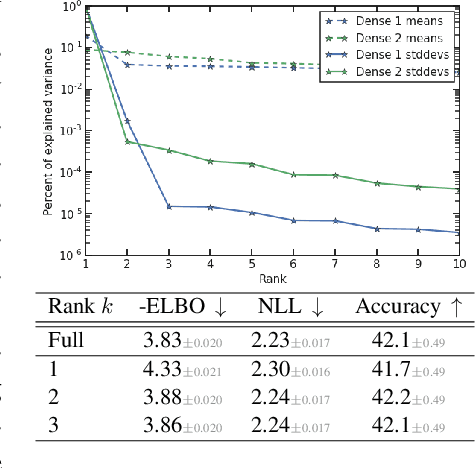
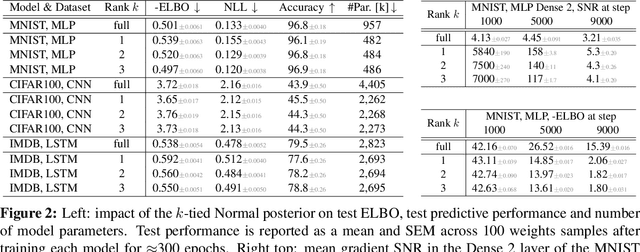

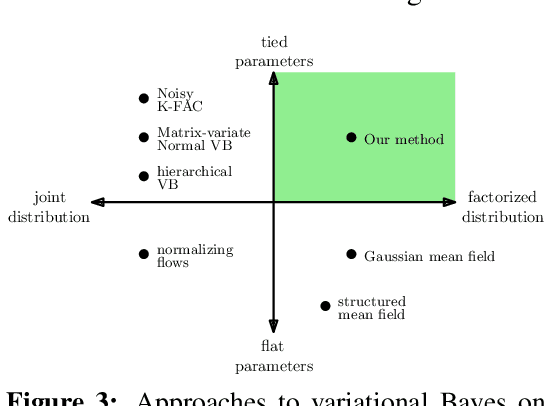
Abstract:Variational Bayesian Inference is a popular methodology for approximating posterior distributions over Bayesian neural network weights. Recent work developing this class of methods has explored ever richer parameterizations of the approximate posterior in the hope of improving performance. In contrast, here we share a curious experimental finding that suggests instead restricting the variational distribution to a more compact parameterization. For a variety of deep Bayesian neural networks trained using Gaussian mean-field variational inference, we find that the posterior standard deviations consistently exhibit strong low-rank structure after convergence. This means that by decomposing these variational parameters into a low-rank factorization, we can make our variational approximation more compact without decreasing the models' performance. Furthermore, we find that such factorized parameterizations improve the signal-to-noise ratio of stochastic gradient estimates of the variational lower bound, resulting in faster convergence.
 Add to Chrome
Add to Chrome Add to Firefox
Add to Firefox Add to Edge
Add to Edge